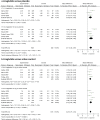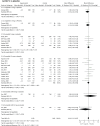Effects of exenatide and liraglutide on heart rate, blood pressure and body weight: systematic review and meta-analysis
- PMID: 23355666
- PMCID: PMC3563145
- DOI: 10.1136/bmjopen-2012-001986
Effects of exenatide and liraglutide on heart rate, blood pressure and body weight: systematic review and meta-analysis
Abstract
Objectives: To synthesise current evidence for the effects of exenatide and liraglutide on heart rate, blood pressure and body weight.
Design: Meta-analysis of available data from randomised controlled trials comparing Glucagon-like peptide-1 (GLP-1) analogues with placebo, active antidiabetic drug therapy or lifestyle intervention.
Participants: Patients with type 2 diabetes.
Outcome measures: Weighted mean differences between trial arms for changes in heart rate, blood pressure and body weight, after a minimum of 12-week follow-up.
Results: 32 trials were included. Overall, GLP-1 agonists increased the heart rate by 1.86 beats/min (bpm) (95% CI 0.85 to 2.87) versus placebo and 1.90 bpm (1.30 to 2.50) versus active control. This effect was more evident for liraglutide and exenatide long-acting release than for exenatide twice daily. GLP-1 agonists decreased systolic blood pressure by -1.79 mm Hg (-2.94 to -0.64) and -2.39 mm Hg (-3.35 to -1.42) compared to placebo and active control, respectively. Reduction in diastolic blood pressure failed to reach statistical significance (-0.54 mm Hg (-1.15 to 0.07) vs placebo and -0.50 mm Hg (-1.24 to 0.24) vs active control). Body weight decreased by -3.31 kg (-4.05 to -2.57) compared to active control, but by only -1.22 kg (-1.51 to -0.93) compared to placebo.
Conclusions: GLP-1 analogues are associated with a small increase in heart rate and modest reductions in body weight and blood pressure. Mechanisms underlying the rise in heart rate require further investigation.
Figures









References
-
- MacDonald PE, El-kholy W, Riedel MJ, et al. The multiple actions of GLP-1 on the process of glucose-stimulated insulin secretion. Diabetes 2002;51(Suppl 3):S434–42 - PubMed
-
- Willms B, Werner J, Holst JJ, et al. Gastric emptying, glucose responses, and insulin secretion after a liquid test meal: effects of exogenous glucagon-like peptide-1 (GLP-1)-(7-36) amide in type 2 (noninsulin-dependent) diabetic patients. J Clin Endocrinol Metab 1996;81:327–32 - PubMed
LinkOut - more resources
Full Text Sources
Other Literature Sources
